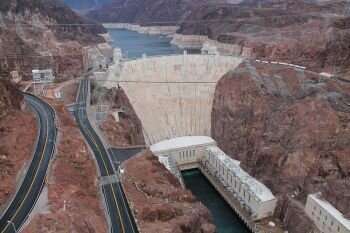No more Hoover dams: Hydropowered countries suffer higher levels of poverty, corruption and debt

Countries relying on the world's biggest and most established source of renewable electricity have seen their poverty, corruption and debt levels rise and their economy slow at significantly greater rates than nations which use other energy resources over the last three decades, a major new study has found.
The study also found that hydropower states did not suffer from a hydroelectric resource curse and did not see an increase in internal conflict to any significant degree while carbon reduction benefits were realised only over time after the initial environmental impact of construction.
The financial benefits of major hydropower projects could also take decades to emerge, the study published today in The Review of International Political Economy found.
The new study by the University of Sussex and the International School of Management in Germany compared the security, political governance, economic development and climate change performance of major hydropower states against oil-producing and all other countries using 30 years of World Bank data.
Lead author Professor Benjamin Sovacool, Professor of Energy Policy at the Science Policy Research Unit at the University of Sussex, said the era of the awe-inspiring mega hydropower projects such as the Hoover Dam in the US and The Three Gorges in China should be coming to an end in favour of smaller projects.
He added: "Even though hydropower might not bring immediate and all-encompassing benefits to a country, it is still a vital source of renewable energy."
In the most rigorous comparative study of its kind, researchers took a global approach that compared national portfolios of hydroelectric infrastructure where previous research has almost entirely focused on the impacts of individual dams or river basins. Additionally, whereas previous research tended to examine only hydropower states, this study compared hydropower countries with OPEC members and non-hydropower states.
The report's authors, Prof Sovacool and Dr. Götz Walter, say the report should be food for thought for major institutions such as the World Bank, currently calling for substantial and global investment in hydropower as a means towards international development. They add it is a warning to the cheerleaders of major projects such as the Grand Inga Dam in the Democratic Republic of Congo, a $80 billion project costing twice the country's annual GDP, who promise speedy and far-reaching economic impact on a transformational scale.
The authors added that while hydroelectricity brought countries improved energy access, economic development and positive spillover effect, the championing of large-scale dam projects to bring about industrialization were not supported by the data analysis.
They also recommend that global bodies backing hydroelectric need to better recognize, and perhaps compensate, potential losers of their schemes. The World Commission on Dams estimated that about four million people were displaced annually by hydroelectricity construction or operation while another study looking at global energy accidents over 100 years found hydroelectric dams were responsible for less than 1 percent of total energy accidents but caused 94 percent of reported fatalities and $9.7 billion in damages.
Prof Sovacool said: "Our results bring into focus some of the pernicious trade-offs that can occur as one seeks to transition to large-scale sources of energy supply: bringing in jobs and generating economic activity, but also inviting corruption; seeking to supplant fossil-fuels (and lower carbon emissions), but only by increasing levels of debt, or creating new energy security threats."
The study found that the level of corruption in hydropower countries scored even higher than petro-states such as Saudi Arabia, Qatar and Libya although not to a statistically significant level.
The authors recommend that smaller-scale, run-of-river designs that can operate without reservoirs, as deployed in Nepal, Tanzania and Sri Lanka, could be used more widely to limit corruption and environmental problems and increase developmental outcomes while still producing sufficient energy to meet demand.
Prof Walter, of the International School of Management ISM in Germany, said: "While it has to be kept in mind that our data analysis was correlative and does not automatically imply a negative causal effect of hydropower on poverty, corruption and debt, it is noteworthy that we found any effects at all on the national level, even though hydropower stands for such a small part of respective countries' economies. Practitioners maybe should rethink their underlying assumptions about how they evaluate hydropower's risk."
The researchers used country metrics and data to explore six hypotheses about the impact in countries with significant hydropower operations on conflict, poverty, economic growth, national debt, corruption and the environment.
The research team used data from the Uppsala Conflict Data Programme; poverty gap figures, GDP per capita data, total debt stocks figures, the World Bank's Worldwide Governance Indicators and metric greenhouse gas emissions per capita.
The data was analysed over three timeframes with data from 25 hydropower countries, 11 OPEC countries and 77 hydropower countries used in the first timeframe of 1985-1994. Thirty-three hydropower countries, 10 OPEC, and 94 non-hydropower were analysed in timeframe 2 1995-2004 and 23 hydropower countries, 9 OPEC and 108 non-hydropower in timeframe 3 2005-2014.
Hydropower states are defined in this report as countries using dams for at least 70 percent of national electricity.
Hydropower is the largest source of renewable electricity around the world providing 16.3 percent of the world's electricity and 85 percent of its renewable power in 2015. Hydroelectric dams are active in more than 150 countries, generating at least 50 percent of total electricity in more than 60 countries and greater than 90 percent in more than 20. Of the $11.1 trillion the world was anticipated to spend on energy infrastructure from 2005 to 2030, $1.9 trillion was expected to go exclusively to hydropower (Haas, 2008).
More information: Benjamin K. Sovacool et al. Internationalizing the political economy of hydroelectricity: security, development and sustainability in hydropower states, Review of International Political Economy (2018). DOI: 10.1080/09692290.2018.1511449
Provided by University of Sussex



















